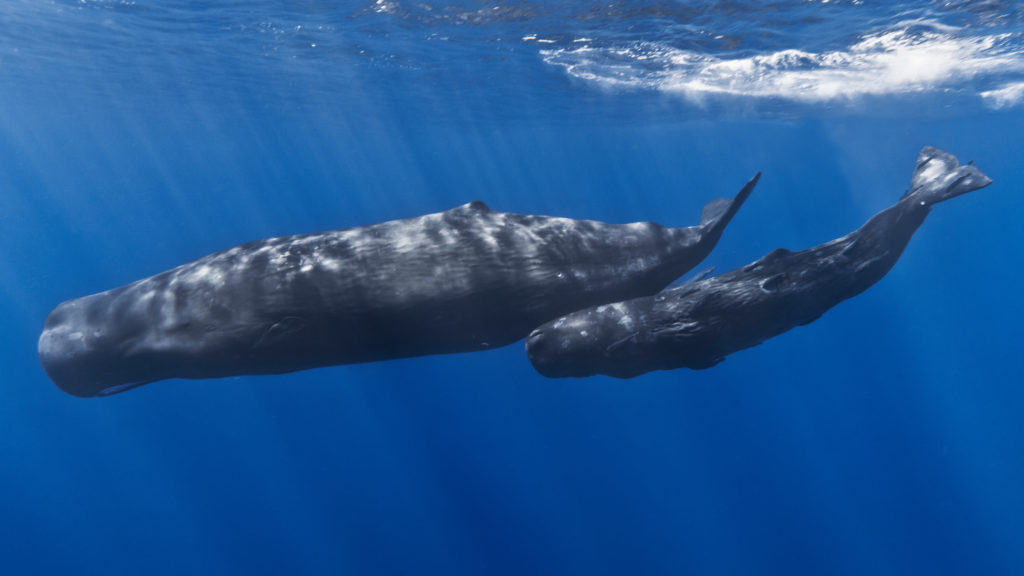Keep the Noise Down! The Other Side of Ocean Pollution
By Neele Elbersgerd
Cognitive Neuroscientist, Freie Universität Berlin/University of Hamburg

When I say ocean pollution, the first thing that probably comes to mind is garbage and microplastic. But another big pollutant in the oceans is gaining increasing attention: noise.
Our oceans are loud places. Whales, dolphins, fish, and even corals produce sounds that shape underwater life. And while some humans love listening to “underwater soundscapes” (e.g., dolphin and whale sounds), the anthropogenic (human-made) noise that marine animals have to endure is anything but comforting.
Humans are noisy intruders
Anthropogenic sounds from transport, construction, offshore exploration, and mining have made the once peaceful environment a loud cacophony of sound that is extremely damaging for marine wildlife.
There are three major sources of human-made noise:1
- Propellers of ships, especially when dirty or damaged
- Seismic airguns which are used to map out the ocean floor in search of oil and gas
- Pile driving; a process used to build foundations of ocean infrastructures (like wind farms or oil rigs)
The increased anthropogenic noise in marine environments, and its consequences, are often connected to trading route hotspots. In contrast, where there are no ships, the marine soundscapes remain pristine.2
How noise impacts the oceans
The impact of industrial noise pollution on marine wildlife is alarming. The noise levels stress over 150 species – not only whales and dolphins, but also invertebrates like jellyfish, octopuses, and coral reefs.3
Animals who rely on sound to communicate get disoriented, leading to aimless swimming or mass strandings.
Anthropogenic noise reduces animals’ ability to communicate or use echolocation: animals try to avoid areas if they are sufficiently loud, and it dampens their detection of environmental cues that inform navigation.4
For example, noise slows down whale migration times by up to 20 per cent, and may even trap whales behind a ‘wall of noise’ if levels continue to rise.4
Predator and prey detection, feeding behaviours, as well as mating, are increasingly disturbed. All of these are made understandably more difficult with the sound of seismic airguns nearby.
Solutions: so close yet so far
Unlike with plastic, noise reduction can be tackled quickly and – if addressed – should show effects immediately. A report from the U.N.’s Convention on the Conservation of Migratory Species of Wild Animals (CMS) outlines possible solutions:1
- Cleaning and checking propellers regularly for damage
- Slowing down ships by 10%, which will reduce noise impact by 40%
- Using quieter marine vibrator systems to map out the seabed instead of seismic airguns
- Restricting areas of drilling to less sensitive habitats and away from migration routes
- Using BLUE Piling (using a large water mass as a ram to drive down piles instead of steel hammers)
We have solutions – but implementing them is another thing. These new technologies are not yet widely available and introduce additional costs.
Additionally, one of the best and worst parts about the ocean is that it belongs to everyone. Implementing and reinforcing regulations on an international level is hard and takes a lot of time.
But we should not be – and we are not – giving up.
Several national and international projects have formed over the past years, like Saturn in Europe, or the Global Partnership for Mitigation of Underwater Noise from Shipping (GloNoise Partnership).5,6 Their goal is to raise awareness, study solutions, and communicate them to the big players in the marine economy.
With every decibel dropped, we can bring a little bit of peace back to the deep blue.
If you’re interested to hear what some of these underwater noises sound like, you can listen to recordings of natural and human-made underwater noises at oceanexplorer.noaa.gov/gallery/sound/sound.html
Neele Elbersgerd studied Science Communication at the University of Melbourne during a postgraduate exchange program as part of their Master of Science (Cognitive Neuroscience) at Freie Universität Berlin.
References:
- Weilgart, L. (2023). Best Available Technology (BAT) and Best Environmental Practice (BEP) for Mitigating Three Noise Sources: Shipping, Seismic Airgun Surveys, and Pile Driving – Technical Series No. 46. Convention on the Conservation of Migratory Species of Wild Animals. cms.int/en/publication/best-available-technology-bat-and-best-environmental-practice-bep-mitigating-three-noise
- Erbe, C., et al. (2021). It Often Howls More than It Chugs: Wind versus Ship Noise Under Water in Australia’s Maritime Regions. Journal of Marine Science and Engineering, 9(5), 472–472. doi.org/10.3390/jmse9050472
- Pickrell, J. (September 11 2023). Dampening the deafening din. Australian Geographic. australiangeographic.com.au/topics/science-environment/2023/09/damping-the-deafening-din/
- Johnston, S. T., & Painter, K. J. (2024). Avoidance, confusion or solitude? Modelling how noise pollution affects whale migration. Movement Ecology, 12(1). doi.org/10.1186/s40462-024-00458-w
- Saturn. Developing Solutions to Underwater Noise. saturnh2020.eu/
- International Maritime Organization. GloNoise Partnership. imo.org/en/OurWork/PartnershipsProjects/Pages/GloNoise-Partnership.aspx






